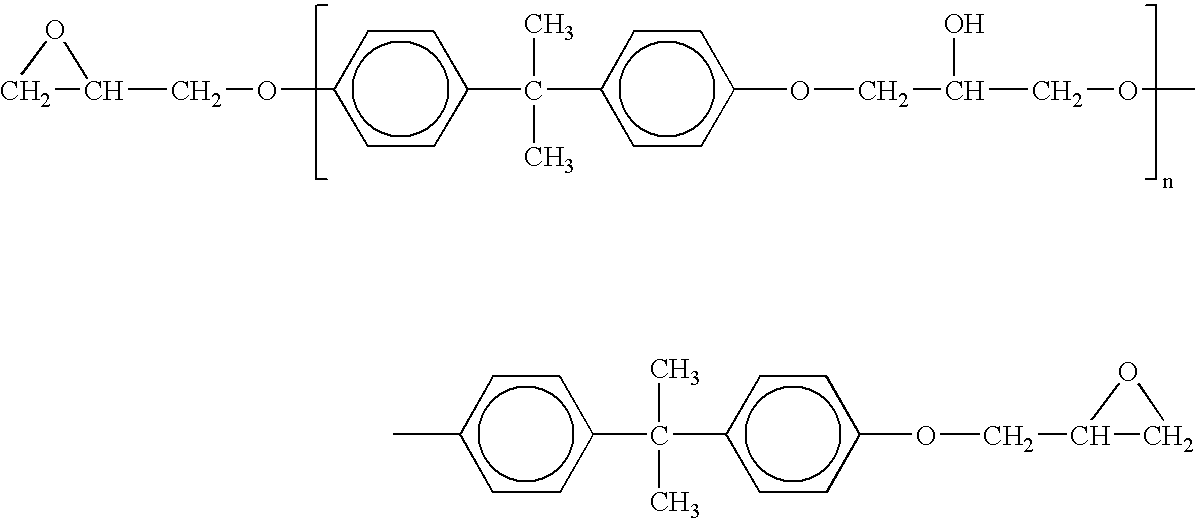Epoxy resin curing agents and epoxy resin compositions
a technology of epoxy resin and curing agent, which is applied in the direction of other chemical processes, organic chemistry, chemistry apparatus and processes, etc., can solve the problems of limited use of typical prepreg curing agent and some resins, composite systems are inherent brittle nature, and conventional toughness modifiers such as thermoplastics and elastomers, and achieve low viscosity and high mechanical properties.
- Summary
- Abstract
- Description
- Claims
- Application Information
AI Technical Summary
Benefits of technology
Problems solved by technology
Method used
Image
Examples
example 1
[0052]Neat resin plaques are made to demonstrate the difference in using the aromatic amine curing technology of the present invention when compared to a commercial liquid aromatic amine, diethylene toluene diamine(DETDA) by the Albelmarle Co. This liquid aromatic amine has an amine active hydrogen equivalent weight of approximately 44.5.
[0053]A liquid aromatic amine curing agent (labeled AA-1), was developed containing the aromatic amine of this invention, and consisted 40 wt % N-phenyl-p-phenylenediamine, 30 wt % 1,8-diaminonaphthalene, and 30 wt % m-phenylenediamine. These solid or flaked aromatic amines were combined in a glass container and placed in a circulating air oven, covered, and heated to 120 C. After melting took place, the liquid amine blend was mixed for another hour. The mixture of aromatic amines was cooled to room temperature and was a stable liquid for a period of at least one month at 21 C. This provided a low viscosity liquid aromatic amine blend for curing epo...
example 2
[0057]The liquid aromatic amine curing agent (AA-1), shown in EXAMPLE 1 and the same epoxy resin, triglycidyl-p-aminophenol, MY 0510 from Vantico were used to VARTM manufacture a composite consisting of 3k-70 P woven fabric containing T300 carbon fibers from Amoco. After infusion, this lay up was then ramped at approximately 2 C / min to 177 C and cured for two hours. The compression ultimate, compression modulus, open hole compression ultimate, in plane shear and per ply thickness were measured. All testing was done in accordance with those testing methods described in Boeing Material Specification 8-256, from Boeing Commercial Airplane Group, The Boeing Company, Seattle, Wash. The results for this testing are listed in Table 2.
[0058]
TABLE 2Compression Ultimate, ksiRoom Temperature / Ambient91160 F. (71 C.) / Wet (14 days in 160 F. Water)64Compression Modulus, msiRoom Temperature / Ambient7.6160 F. (71 C.) / Wet (14 days in 160 F. Water)7.7Open Hole Compression Ultimate, ksiRoom Temperature / ...
example 3
[0059]A liquid aromatic amine curing agent (labeled AA-2), was developed that contained 30 wt % N-phenyl-p-phenylenediamine, 30 wt % m-phenylenediamine, and 40 wt % diethylene toluene diamine. This combination of solid aromatic amines and liquid aromatic amine were combined in a glass container and placed in a circulating air oven, covered, and heated to 120 C. After melting took place, the liquid amine blend was mixed for another hour. The mixture of aromatic amines was cooled to room temperature and was a stable liquid for a period of at least one month at 21 C. The resulting mixture provided a low viscosity aromatic amine blend for curing epoxy resins. The approximate active amine hydrogen equivalent weight was approximately 40 for this mixture. To lower the viscosity of this liquid aromatic amine blend, 25 wt % of a cycloaliphatic amine, bis(4-amino-3-methylcyclohexyl)methane, manufactured by AirProducts and known as Ancamine 2049 was added. Since the active amine hydrogen equiv...
PUM
| Property | Measurement | Unit |
|---|---|---|
| mechanical properties | aaaaa | aaaaa |
| toughness | aaaaa | aaaaa |
| chemical structure | aaaaa | aaaaa |
Abstract
Description
Claims
Application Information
 Login to View More
Login to View More - R&D
- Intellectual Property
- Life Sciences
- Materials
- Tech Scout
- Unparalleled Data Quality
- Higher Quality Content
- 60% Fewer Hallucinations
Browse by: Latest US Patents, China's latest patents, Technical Efficacy Thesaurus, Application Domain, Technology Topic, Popular Technical Reports.
© 2025 PatSnap. All rights reserved.Legal|Privacy policy|Modern Slavery Act Transparency Statement|Sitemap|About US| Contact US: help@patsnap.com



